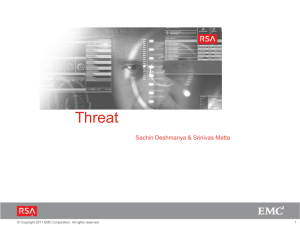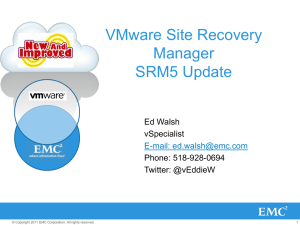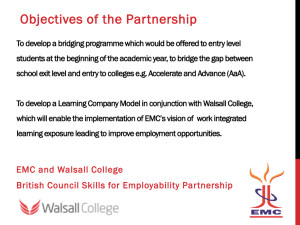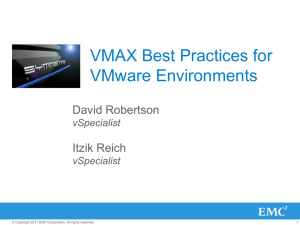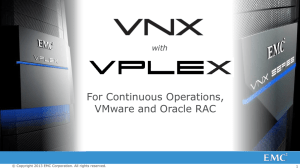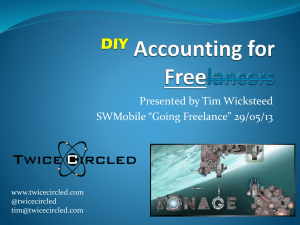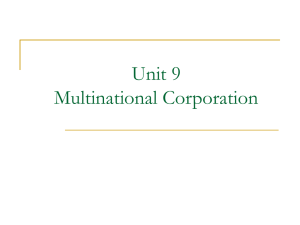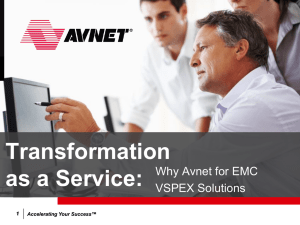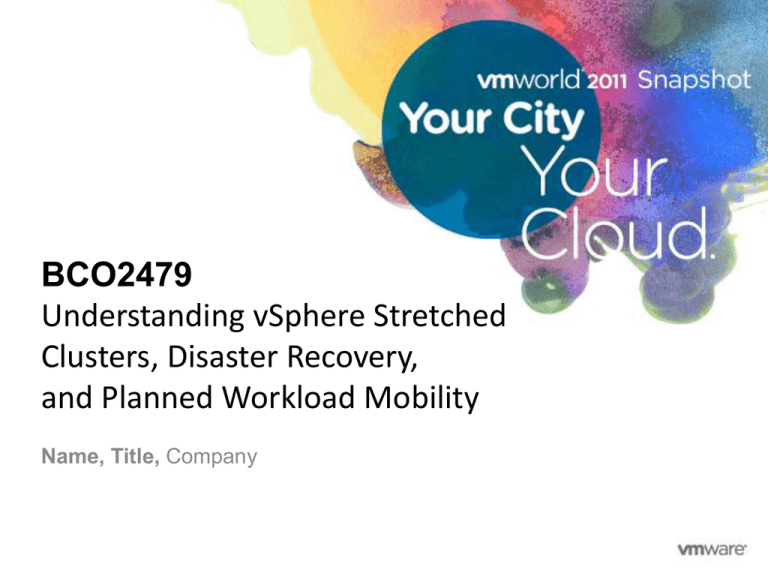
BCO2479
Understanding vSphere Stretched
Clusters, Disaster Recovery,
and Planned Workload Mobility
Name, Title, Company
A couple of things to set the stage…
• EMC and VMware – seeing lots of confusion out
there re: Disaster Recovery (DR) and Disaster
Avoidance (DA)
• Like the blog post series – will break this
session into multiple parts:
–
–
–
–
PART I – Understanding DR and DA
PART II – Understanding Stretched vSphere Clusters
PART III – What’s New?
PART IV – Where are areas where we are working for the
future?
• Will work hard to cover a lot, but leave time for
QnA
© Copyright 2011 EMC Corporation. All rights reserved.
2
PART I…
Understanding DR and DA
© Copyright 2011 EMC Corporation. All rights reserved.
3
“Disaster” Avoidance – Host Level
This is vMotion.
Most important characteristics:
X
• By definition, avoidance,
not recovery.
• “non-disruptive” is
massively different than
“almost non-disruptive”
“Hey… That host WILL need to go down
for maintenance. Let’s vMotion to avoid
a disaster and outage.”
© Copyright 2011 EMC Corporation. All rights reserved.
4
“Disaster” Recovery – Host Level
This is VM HA.
Most important characteristics:
X
• By definition recovery
(restart), not avoidance
• Simplicity, automation,
sequencing
Hey… That host WENT down due to unplanned
failure causing a unplanned outage due to that
disaster. Let’s automate the RESTART of the
affected VMs on another host.
© Copyright 2011 EMC Corporation. All rights reserved.
5
Disaster Avoidance – Site Level
This is inter-site
vMotion.
X
Most important characteristics:
• By definition, avoidance,
not recovery.
• “non-disruptive” is
massively different than
“almost non-disruptive”
Hey… That site WILL need to go down
for maintenance. Let’s vMotion to avoid
a disaster and outage.
© Copyright 2011 EMC Corporation. All rights reserved.
6
Disaster Recovery – Site Level
This is Disaster
Recovery.
X
Most important characteristics:
• By definition recovery
(restart), not avoidance
• Simplicity, testing, split
brain behavior,
automation, sequencing,
IP address changes
Hey… That site WENT down due to unplanned
failure causing a unplanned outage due to that
disaster. Let’s automate the RESTART of the
affected VMs on another host.
© Copyright 2011 EMC Corporation. All rights reserved.
7
Type 1: “Stretched Single vSphere Cluster”
vCenter
vSphere Cluster A
Distance
Distributed Logical Datastore
Information in Datastore @ Site A
© Copyright 2011 EMC Corporation. All rights reserved.
Information in Datastore @ Site B
8
One little note re: “Intra-Cluster” vMotion
• Intra-cluster vMotions can be highly parallelized
– and more and more with each passing vSphere release
– With vSphere 4.1 and vSphere 5 it’s up to 4 per host/128
per datastore if using 1GbE
– 8 per host/128 per datastore if using 10GbE
– …and that’s before you tweak settings for more, and
shoot yourself in the foot :-)
• Need to meet the vMotion network requirements
– 622Mbps or more, 5ms RTT (upped to 10ms RTT if
using Metro vMotion - vSphere 5 Enterprise Plus)
– Layer 2 equivalence for vmkernel (support requirement)
– Layer 2 equivalence for VM network traffic (required)
© Copyright 2011 EMC Corporation. All rights reserved.
9
Type 2: “Multiple vSphere Clusters”
vCenter
vSphere Cluster A
vSphere Cluster B
Distance
Distributed Logical Datastore
Information in Datastore @ Site A
© Copyright 2011 EMC Corporation. All rights reserved.
Information in Datastore @ Site B
10
One little note re: “Inter-Cluster” vMotion
• Inter-Cluster vMotions are serialized
– Involves additional calls into vCenter, so hard limit
– Lose VM cluster properties (HA restart priority, DRS
settings, etc.)
• Need to meet the vMotion network requirements
– 622Mbps or more, 5ms RTT (upped to 10ms RTT if
using Metro vMotion w vSphere 5 Enterprise Plus)
– Layer 2 equivalence for vmkernel (support requirement)
– Layer 2 equivalence for VM network traffic (required)
© Copyright 2011 EMC Corporation. All rights reserved.
11
Type 3: “Classic Site Recovery Manager”
vCenter
Prot.
vCenter
Recov.
vSphere Cluster A
vSphere Cluster B
Distance
Array-based (sync, async or
continuous) replication or
vSphere Replication v1.0 (async)
Datastore A
© Copyright 2011 EMC Corporation. All rights reserved.
Read-only (gets promoted or
snapshoted to become writeable)
replica of Datastore A
12
Part I - Summary
• People have a hard time with this… Disaster
Avoidance != Disaster Recovery
– Same logic applies at a server level applies at the site level
– Same value (non-disruptive for avoidance, automation/simplicity for
recovery) that applies at a server level, applies at the site level
• Stretched clusters have many complex considerations
• SRM and non-disruptive workload mobility are
mutually exclusive right now
– vMotion = single vCenter domain vs. SRM = two or more vCenter
domains
– Note – people use SRM for workload mobility all the time (and is
improved in vSphere 5/SRM 5) – but this is always disruptive
– SRM remains the simplest, cleanest solution across many use
cases.
© Copyright 2011 EMC Corporation. All rights reserved.
13
PART II…
vSphere Stretched Clusters
Considerations
© Copyright 2011 EMC Corporation. All rights reserved.
14
Stretched Cluster Design Considerations
• Understand the difference compared to
DR
– HA does not follow a recovery plan workflow
– HA is not site aware for applications, where are all the
moving parts of my app? Same site or dispersed? How
will I know what needs to be recovered?
• Single stretch site = single vCenter
– During disaster, what about vCenter setting consistency
across sites? (DRS Affinity, cluster settings, network)
• Will network support? Layer2 stretch? IP
mobility?
• Cluster split brain = big concern, how to
handle?
Not necessarily cheaper solution, read between the lines (there
© Copyright 2011 EMC Corporation. All rights reserved.
15
Stretched Storage Configuration
• Literally just stretching the SAN fabric (or NFS
exports over LAN) between locations
• Requires synchronous replication
• Limited in distance to ~100km in most cases
• Typically read/write in one location, read-only in
second location
• Implementations with only a single storage
controller at each location create other
considerations.
© Copyright 2011 EMC Corporation. All rights reserved.
16
Stretched Storage Configuration
Read/Write
© Copyright 2011 EMC Corporation. All rights reserved.
Stretched Storage Fabric(s)
X
X
Read-Only
17
Distributed Virtual Storage Configuration
• Leverages new storage technologies to distribute
storage across multiple sites
• Requires synchronous mirroring
• Limited in distance to ~100km in most cases
• Read/write storage in both locations, employs data
locality algorithms
• Typically uses multiple controllers in a scale-out
fashion
• Must address “split brain” scenarios
© Copyright 2011 EMC Corporation. All rights reserved.
18
Distributed Virtual Storage Configuration
X
Read/Write
© Copyright 2011 EMC Corporation. All rights reserved.
X
Read/Write
19
EMC VPLEX Overview
• EMC VPLEX falls into the distributed virtual storage
category
• Keeps data synchronized between two locations
but provides read/write storage simultaneously at
both locations
• Uses scale-out architecture with multiple engines in
a cluster and two clusters in a Metro-Plex
• Supports both EMC and non-EMC arrays behind the
VPLEX
© Copyright 2011 EMC Corporation. All rights reserved.
20
VPLEX – What A Metro-Plex looks like
© Copyright 2011 EMC Corporation. All rights reserved.
21
Preferred Site in VPLEX Metro
• VPLEX Metro provides
read/write storage in two
locations at the same time
(AccessAnywhere)
• In a failure scenario, VPLEX
uses “detach rules” to prevent
split brain
– A preferred site is defined on a perdistributed virtual volume (not site
wide) basis
– Preferred site remains read/write;
I/O halted at non-preferred site
Read/
write
Read/
write
I/O Halted
(VMware PDL
response)
Distributed Virtual Volume
X
IP/FC links
for Metro-Plex
Preferred
Site
NonPreferred Site
• Invoked only by entire cluster
failure, entire site failure, or
cluster partition
© Copyright 2011 EMC Corporation. All rights reserved.
22
Configuring Preferred Site…
© Copyright 2011 EMC Corporation. All rights reserved.
23
Something to understand re: yanking &
“suspending” storage…
• What happens when you “yank” storage?
– VMs who’s storage “disappears” or goes “read-only” behave
indeterminately
– Responding to a ping doesn’t mean a system is available (if it
doesn’t respond to any services, for example)
– There’s no chance of “split brain” data
– But – VMs can stay alive for surprisingly long
– Conversely, sometimes, VMs blue-screen quickly
• Yanked: http://www.youtube.com/watch?v=6Op0i0cekLg
• Suspended: http://www.youtube.com/watch?v=WJQfy7-udOY
© Copyright 2011 EMC Corporation. All rights reserved.
24
Stretched Cluster Considerations #1
Consideration: Without read/write storage at both
sites, roughly half the VMs incur a storage
performance penalty
• With stretched Storage Network configurations:
– VMs running in one site are accessing storage in another site
– Creates additional latency for every I/O operation
• With distributed virtual storage configurations:
– Read/write storage provided, so this doesn’t apply
© Copyright 2011 EMC Corporation. All rights reserved.
25
Stretched Cluster Considerations #2
Consideration: Prior to and including vSphere 4.1,
you can’t control HA/DRS behavior for “sidedness”
• With stretched Storage Network configurations:
– Additional latency introduced when VM storage resides in
other location
– Storage vMotion required to remove this latency
• With distributed virtual storage configurations:
– Need to keep cluster behaviors in mind
– Data is access locally due to data locality algorithms
© Copyright 2011 EMC Corporation. All rights reserved.
26
Stretched Cluster Considerations #3
Consideration: With vSphere 5, you can use
DRS host affinity rules to control HA/DRS
behavior
• With all storage configurations:
– Doesn’t address HA primary/secondary node selection (see
What’s New, vSphere 5)
• With stretched Storage Network
configurations:
– Beware of single-controller implementations
– Storage latency still present in the event of a controller failure
• With distributed virtual storage
configurations:
– Plan for cluster failure/cluster partition behaviors
• Note – not supported in vSphere 4.1, and until
© Copyright 2011 EMC Corporation. All rights reserved.
27
Stretched Cluster Considerations #4
Consideration: There is no supported way to
control VMware HA primary /secondary node
selection with vSphere 4.x
• With all storage configurations:
– Limits cluster size to 8 hosts (4 in each site)
– No supported mechanism for controlling/specifying
primary/secondary node selection
– Methods for increasing the number of primary nodes
also not supported by VMware
• Note: highly recommended reading (just
ignore non-supported notes) : http://www.yellowbricks.com/vmware-high-availability-deepdive/
• vSphere 5 VM HA implementation changes
things…
© Copyright 2011 EMC Corporation. All rights reserved.
28
Stretched Cluster Considerations #5
Consideration: Stretched HA/DRS clusters (and intercluster vMotion also) require Layer 2 “equivalence”
at the network layer
• With all storage configurations:
– Complicates the network infrastructure
– Involves technologies like OTV, VPLS/Layer 2 VPNs
• With stretched Storage Network configurations:
– Can’t leverage vMotion at distance without storage latency
• With distributed virtual storage configurations:
– Data locality enables vMotion at distance without latency
• Note how the SRM automated IP change is much
simpler in many cases
© Copyright 2011 EMC Corporation. All rights reserved.
29
Stretched Cluster Considerations #6
Consideration: The network lacks site awareness, so
stretched clusters introduce new networking
challenges.
• With all storage configurations:
– The movement of VMs from one site to another doesn’t
update the network
– VM movement causes “horseshoe routing” (LISP, a future
networking standard, helps address this)
– You’ll need to use multiple isolation addresses in your
VMware HA configuration
• Note how the SRM automated IP change is much
simpler in many cases
© Copyright 2011 EMC Corporation. All rights reserved.
30
Summary – and recommendations
Solutio Description
n Type
Don’t let storage
For Disaster For
Pros
Avoidance,
vendors
(me Disaster
included) do the
you…
Recovery,
on you…
you.
Cons
Jedi mind trick
Type 1:
“Stretche
d Single
vSphere
Cluster”
Single cluster,
storage actively
accessible in both
places.
vMotion between
sites
Try to use VM
HA, though
likely use
scripting in
practice.
• Killer in a demo
• Works very well in
a set of failure
cases
• VM granularity
• Places funky
cluster and
VM HA
restrictions
• More
complex
Type 2:
“Multiple
vSphere
Clusters”
Multiple clusters,
storage actively
accessible in both
places
vMotion between
sites
Scripting
• DA and DR in
broad use cases
• No VM HA
restrictions
• There’s no
escaping
scripting for
DR
• More
complex
Type 3:
“Classic
Site
Recovery
Manager”
2 sites in a
protected/recovery
relationship (can
be bidirectional,
and can be N:1)
• Disruptive. For
a VM,
deregister,
register, fix
SRM
• Or, use SRM to
do en-masse still disruptively
Site Recovery
Manager
• Best RPO/RTO
across the
broadest set of
use cases
• Simple, robust,
DR testing and
failover
• Plan
granularity
• Mobility
between sites
is disruptive.
In the paraphrased words of Yoda… “think not of the sexy
demo, think of operations during the disaster – there is
no try”
© Copyright 2011 EMC Corporation. All rights reserved.
31
PART III…
What’s new….
© Copyright 2011 EMC Corporation. All rights reserved.
32
So – what’s new?
• NOW – Site Recovery Manager 5.0
• NOW – vSphere 5 VM HA rewrite & heartbeat
datastores, help on partition scenarios
• NOW – vSphere 5 Metro vMotion
• NOW – Improved VPLEX partition behavior – will mark
the target as “dead”, works better with vSphere
• NOW – VPLEX cluster interconnect and 3rd party
witness
© Copyright 2011 EMC Corporation. All rights reserved.
33
SRM 5.0 New Features
• New Workflows – inc Failback!!!
• Planned migration – with replication update
• vSphere Replication framework
• Redesigned UI – true single pane of glass configuration
• Faster IP customization
• SRM specific Shadow VM icons at recovery site
• In guest scripts callout via recovery plans
• VM dependency ordering during configurable
• …..and a LOT more….
© Copyright 2011 EMC Corporation. All rights reserved.
34
SRM 5.0 – Automated Failback
• Reprotect VMs from Site B to
Site A
– Reverse Replication
– Apply reverse resource map
• Automate failover Site B to
Site A
Reverse original recovery plan
Site A
Site B
– Reverse original recovery plan
• Simplify failback process
– Automate replication management
– Eliminate need to set up new
recovery plan and cleanup
vSphere
vSphere
Reverse
Replication
• Restrictions
– Does not apply if Site A physically
lost
– Not available at GA with vSphere
© Copyright 2011 EMC Corporation. All rights reserved.
35
SRM 5.0 – vSphere Replication
Adding native replication to SRM
source
target
• VMs can be replicated regardless of the underlying storage
• Enables replication between heterogeneous datastores
• Replication is managed as a property of a virtual machine
• Efficient replication minimizes impact on VM workloads
• Considerations: Scale, Failback, Consistency Groups
© Copyright 2011 EMC Corporation. All rights reserved.
36
vSphere 5.0 - HA
• Complete re-write of vSphere HA
• Elimination of
Primary/Secondary concept
• Foundation for increased scale
and functionality
ESX 01
ESX 03
ESX 02
ESX 04
– Eliminates common issues (DNS resolution)
• Multiple Communication Paths
– Can leverage storage as well as the mgmt
network for communications
– Enhances the ability to detect certain types of
failures and provides redundancy
• IPv6 Support
• Enhanced User Interface
• Enhanced Deployment
© Copyright 2011 EMC Corporation. All rights reserved.
37
vSphere 5.0 HA – Heartbeat Datastores
• Monitor availability of Slave hosts
and VMs running on them
• Determine host network isolated VS
network partitioned
• Coordinate with other Masters – VM
can only be owned by one master
ESX 01
ESX 03
ESX 02
ESX 04
• By default, vCenter will automatically
pick 2 datastores
• Very useful for hardening
stretched storage models
© Copyright 2011 EMC Corporation. All rights reserved.
38
Metro vMotion – Stretched Clusters
• Enable vMotion across
longer distances
• Workload balancing
between sites
• Less latency sensitive
• Work underway on support
Site A
Site B
• Work underway on building
upon 4.1 vSphere DRS host
affinity groups
© Copyright 2011 EMC Corporation. All rights reserved.
39
What’s new with VPLEX 5.0
GeoSynchrony 5.0 for
VPLEX
• Expanded 3rd party storage support
• VP-Copy for EMC arrays
• Expanded array qualifications (ALUA)
• VPLEX Witness
• Host cross-cluster connected
• VPLEX Element Manager API
• VPLEX Geo
© Copyright 2011 EMC Corporation. All rights reserved.
40
VS2: New VPLEX Hardware
• Faster Intel multi-core processors
• Faster engine interconnect interfaces
• Space-efficient engine form factor
• Third-party rack support
Migrated an entire datacenter – saving $500,000 in revenue
VPLEX paid for itself twice-over in a single event. As a hospital
they did not have to interrupt healthcare.
“I'm sure glad we made the DR investment. It took a lot of
pressure off us. We ran the DR virtual farm over 50 hours. This
is solid stuff. VPLEX is well worth the investment by the way.”
CIO, Northern Hospital of Surry County
© Copyright 2011 EMC Corporation. All rights reserved.
41
VPLEX Witness
• Use with VPLEX Metro and
VPLEX Geo
VPLEX
WITNESS
• Coordinates seamless
failover
LUN A A C C E S S A N Y W H E R E
LUN A
• Runs as a virtual machine
within an ESX host
• Connects to VPLEX
through IP
Integrates with hosts, clusters, applications to
automate failover and recovery
© Copyright 2011 EMC Corporation. All rights reserved.
42
VPLEX Family Use Cases
MOBILITY
Cluster A
AVAILABILITY
COLLABORATION
Cluster B
ACCESS ANYWHERE
ACCESS ANYWHERE
Maintain availability and
non-stop access by
mirroring across locations
Enable concurrent
read/write access to data
across locations
Disaster avoidance
High availability
Data center migration
Eliminate storage
operations from failover
Instant and simultaneous
data access over distance
ACCESS ANYWHERE
Move and relocate
VMs, applications, and
data over distance
Workload rebalancing
© Copyright 2011 EMC Corporation. All rights reserved.
Streamline workflow
43
VPLEX Family Product Matrix
Local
Metro
Geo
Mobility
Within a data center
Synchronous: approximately 100 km
Asynchronous: approximately 1,000 km
Availability
High availability
VPLEX Witness support
Cross-cluster connected configuration
Collaboration
Between two sites
© Copyright 2011 EMC Corporation. All rights reserved.
44
For More Information…
• Using VPLEX Metro with VMware HA:
http://kb.vmware.com/kb/1026692
• vMotion over Distance Support with VPLEX
Metro:
http://kb.vmware.com/kb/1021215
• VPLEX Metro HA techbook (also available at
the EMC booth)
http://powerlink.emc.com/km/live1/en_US/Offeri
ng_Technical/Technical_Documentation/h7113vplex-architecture-deployment-techbook.pdf
• VPLEX Metro with VMware HA
http://powerlink.emc.com/km/live1/en_US/Offeri
ng_Technical/White_Paper/h8218-vplex-metrovmware-ha-wp.pdf
© Copyright 2011 EMC Corporation. All rights reserved.
45
PART IV…
What we’re working on….
© Copyright 2011 EMC Corporation. All rights reserved.
46
The coolness is accelerating….
• Ongoing SRM and VM HA enhancements
• Hardening the Metro use case and enhancing
support models:
– This includes a much more robust test harness – result of a
lot of joint work.
– Result of a lot of demand for stretched cluster models.
• Improving stretched cluster + SRM coexistence
• Too many things to cover today….quick look at just
a few of them….
© Copyright 2011 EMC Corporation. All rights reserved.
47
VM Component Protection
• Detect and recover from catastrophic infrastructure
failures affecting a VM
– Loss of storage path
– Loss of Network link connectivity
• VMware HA restarts VM on available healthy host
VMware ESX
© Copyright 2011 EMC Corporation. All rights reserved.
VMware ESX
48
Automated Stretched Cluster Config
• Leverage the work in VASA and VM Granular
Storage (VSP3205)
• Automated site protection for all VM’s
• Benefits of single cluster model
• Automated setup of HA and DRS affinity rules
HA/DRS Cluster
Distributed Storage Volumes
Layer 2 Network
Site A
© Copyright 2011 EMC Corporation. All rights reserved.
Site B
49
Increased Topology Support
SRM (future)
Metro Distance
Storage Clusters,
Sync
MetroHA (today)
SRM (future)
Site A
Site C
Site B
Geo Distance Storage
Clusters, Async
SRM (future)
Site A
© Copyright 2011 EMC Corporation. All rights reserved.
Site B
50
Q & A – Part 1 – Questions from us to
you.
• “I think a stretched cluster is what we need… How do I
know?”
• “I think a DR solution is what we need... How do I know?”
• “Stretched clustering sounds like awesomesauce, why not?”
• “Our storage vendor/team tells us their disaster avoidance
solution will do everything we want, HA, DA, DR, we are not
experts here, should we be wary?”
• “Our corporate SLA’s for recovery are simple BUT we have
LOTS of expertise and think we can handle the bleeding edge
stuff should we just go for it???”
© Copyright 2011 EMC Corporation. All rights reserved.
51
Q & A – Part 2 – Questions from us to
you.
• “Can we have our cake and eat it yet? We want BOTH
solutions together?”
• “Is there anything the storage vendors are NOT telling us that
might make running this day to day costly from an opex point
of view?”
• “Why does one solution use a single vCenter yet the other
uses two?? the DR solution seems less flexible and more
complex to manage, is that fair?”
• “My datacenter server rooms are 50 ft apart but i definitely
want a DR solution what's wrong with that idea?”
© Copyright 2011 EMC Corporation. All rights reserved.
52
Q & A – Part 3 – We would love to hear…
Looking to async distances….
• Is “cold migration” over distance good enough for
you, or is it live or nothing?
• Would you pay for it (easiest litmus test of “nice to
have”)
• Would you be willing to be very heterogenous to
use it?
• What are your thoughts on networking solutions
(are you looking at OTV type stuff?)
© Copyright 2011 EMC Corporation. All rights reserved.
53
Want to Learn More?
Tuesday
–
–
–
–
–
EMC Sessions
10:00 - SUP1006 – Accelerate the Journey to Your Cloud
12:00 - VSP1425 – Ask the Expert vBloggers
14:30 - SPO3977 – Next-Generation Storage and Backup for Your Cloud
16:00 - BCA1931 – Design, Deploy, and Optimize SharePoint 2010 on vSphere
16:30 - BCO2479 – Understanding VMware vSphere Stretched Clusters, Disaster Recovery, and Workload
Mobility
17:30 - VSP1926 – Getting Started in vSphere Design
Want to play and try to break VNX, VNXe,
Wednesday
VMAX,
VPLEX,
Avamar
VMs (plus
– 9:30 - BCA2320
– VMware
vSphere 5: BestIsilon,
Practices for
Oracle RAC Virtualization
– 9:30 - CIM2343 – Building a Real-Life High-Performance Financial Services Cloud
many more)? Check out the VMware
– 14:30 - LAS4014 – EMC Partner Hands-on Lab Design, Development, and Implementation
– 16:00 - SPO3976
– Real-World
Big
Data Use
Cases
Made Possible
by Isilon OneFSLabs!
Storage and VMware
Partner
HoL
and
the
EMC
Interactive
vSphere
–
Thursday
–
12:30 - BCA1931 – Design, Deploy, and Optimize SharePoint 2010 on vSphere
Solutions Exchange
• EMC Booth (#1101)
– Demos, Meetups, Customer
Presentations, Cloud Architects
• Interactive Demos (#1001)
© Copyright 2011 EMC Corporation. All rights reserved.
Join the Hunt!
Join the vSpecialist Scavenger
Hunt! Follow Twitter hashtag
#vhunt for your chance to win!
After VMworld
Keep the conversation going in the
“Everything VMware at EMC” online
community:
emc.com/vmwarecommunity
54
THANK YOU
© Copyright 2011 EMC Corporation. All rights reserved.
55

